Granola recipe has evolved from a humble hippie snack to a globally loved pantry staple. Whether sprinkled over smoothie bowls, layered in parfaits, or eaten by the handful, its crunchy texture and sweet-nutty flavor have made it a must-have for healthy kitchens.
But not all granola is created equal. Between sugar-laden store-bought blends and customizable homemade batches, there’s a lot to unpack. That’s why understanding the health benefits of granola, and finding the right granola recipe, is key to making the best choice for your lifestyle.
Even better? Learning to make it yourself gives you control over ingredients, nutrition, and flavor. This guide will show you exactly how.
Pair your granula with a Banana Milkshake for a satisfying snack, or explore our Tropical Smoothie Recipes for even more breakfast inspiration.
What Is Granola Made Of?
At its core, granola is a crunchy mixture of rolled oats, nuts, seeds, and sweeteners, baked until golden and fragrant. Often enjoyed as a breakfast cereal, snack, oryogurt topping, granola recipe is a go-to for anyone seeking both flavor and texture in their meals.
Here’s a breakdown of common granola recipe components:
- Rolled oats – the heart of most granola blends
- Nuts – almonds, walnuts, cashews, pecans
- Seeds – sunflower seeds, pumpkin seeds, chia, flax
- Natural sweeteners – maple syrup, honey, or agave
- Oils – coconut oil, olive oil, or avocado oil
- Flavoring – cinnamon, vanilla, nutmeg, or cardamom
- Dried fruits – raisins, cranberries, chopped dates, or apricots (added after baking)
- Optional add-ins – puffed grains, coconut flakes, dark chocolate, or protein powder
💡 Pro tip: What makes granola so unique is its flexibility, you can tailor every batch to your taste or dietary needs.

Nutritional Breakdown & Health Benefits of Granola
Despite sometimes being labeled as a high-calorie snack, granola recipe, especially when made at home or chosen mindfully, can be a nutrient-dense powerhouse. The secret lies in its wholesome ingredients: oats, nuts, seeds, and natural sweeteners. Together, they create a functional food that supports energy, digestion, and long-lasting satiety.
Whether you’re enjoying it in the morning or as a mid-afternoon snack, granola delivers essential vitamins, minerals, and macronutrients your body will thank you for.
1. Key Health Benefits of Granola:
Fiber
- Found in oats, seeds, and dried fruit
- Supports digestion
- Helps maintain stable blood sugar
- Promotes long-lasting fullness
Healthy Fats
- Derived from nuts and seeds like almonds, walnuts, chia, and flax
- Aid in the absorption of fat-soluble vitamins (A, D, E, and K)
- Help lower bad cholesterol levels when eaten in moderation
Plant-Based Protein
- A combination of oats, nuts, and seeds
- Helps with muscle repair and keeps you satisfied
- Boosted when paired with yogurt or a plant-based milk
Iron & Magnesium
- Found in pumpkin seeds, oats, and almonds
- Support energy metabolism
- Play a role in oxygen transport, muscle function, and mood regulation
Antioxidants
- Present in dried fruits, nuts, and seeds
- Help fight oxidative stress
- Contribute to skin health and immune support
Prebiotics
- Oats are a natural prebiotic food
- Feed the good bacteria in your gut
- Improve digestion, immunity, and overall gut balance
💡 Pro tip: When eaten in moderation and made with balanced, natural ingredients, granola isn’t just delicious, it’s incredibly nourishing.
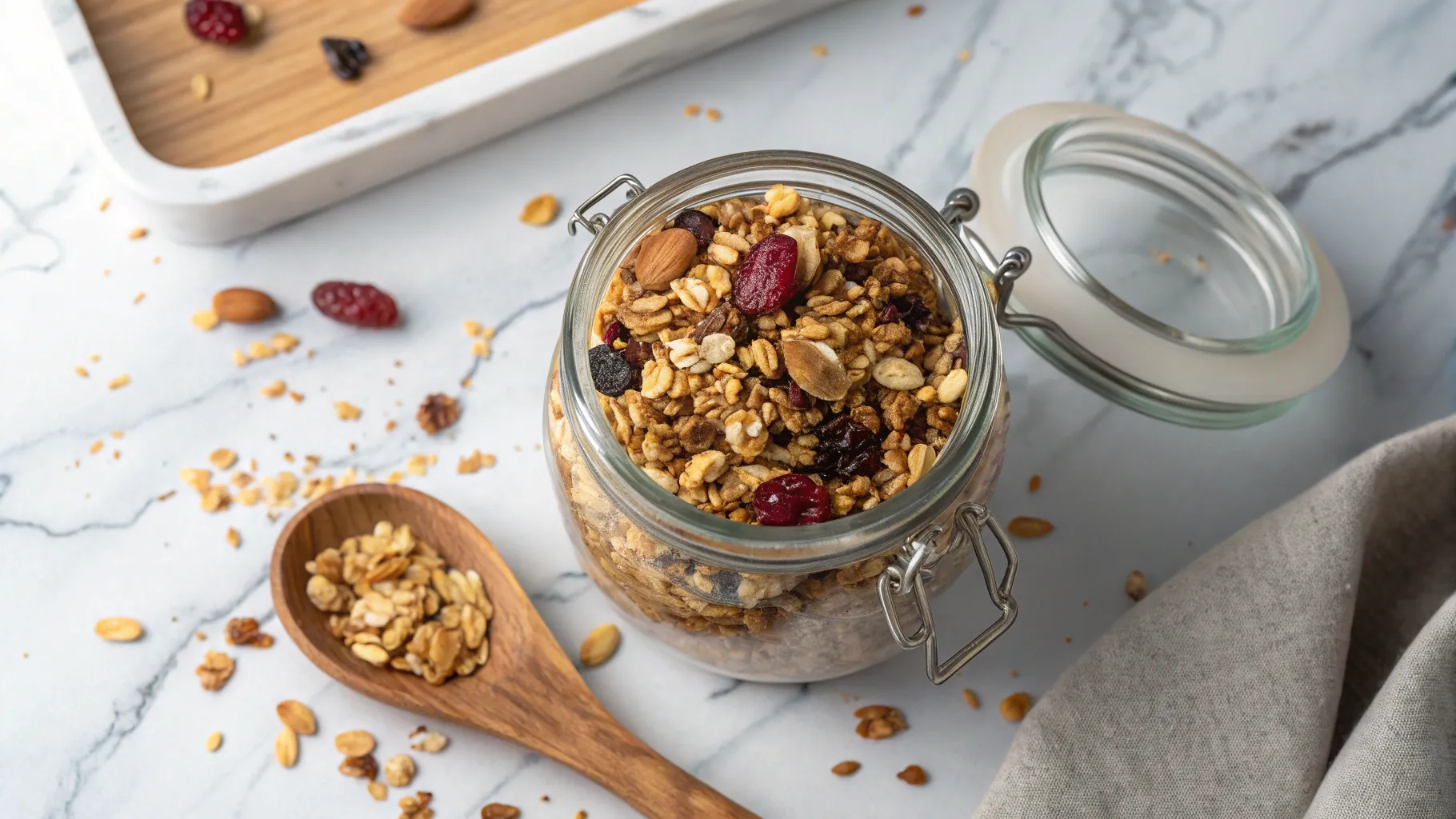
Watch for These in Store-Bought Granola
While granola recipe has a reputation for being a health food, many store-bought varieties can be sneaky sugar bombs in disguise. Colorful packaging and labels like “natural” or “organic” don’t always tell the full story. That’s why it’s essential to flip the package over and check the ingredient list and nutrition label.
Below are some common pitfalls to avoid when shopping for prepackaged granola.
1. Hidden Added Sugars
- Look out for corn syrup, evaporated cane juice, brown rice syrup, and glucose syrup
- Even “natural” sweeteners like agave or fruit concentrates can spike blood sugar
- Some brands contain as much sugar per serving as candy bars
- Aim for less than 5–7g of sugar per 1/4 cup serving
2. Excess Saturated Fats
- Many store-bought granolas use palm oil, canola oil, or hydrogenated fats
- These can increase LDL (“bad”) cholesterol when consumed in excess
- Look for versions with heart-healthy oils like olive oil or coconut oil in moderation
3. Artificial Flavors & Preservatives
- Some commercial granolas add synthetic flavoring or chemical preservatives to extend shelf life
- Common culprits: BHT, artificial vanilla, propylene glycol
- Choose products with clean labels and recognizable ingredients (e.g., cinnamon, oats, nuts)
4. Oversized Portions & Calorie Overload
- Serving sizes can be misleading, often listed as ¼ cup, while the bag may imply a bowlful
- A large bowl can quickly add up to 400–600 calories without toppings
- Always measure your portion and pair it with fresh fruit or plain yogurt for balance
💡 Pro tip: Just because it’s labeled “healthy” doesn’t mean it is. Read labels carefully and opt for brands with whole ingredients and minimal sweeteners.
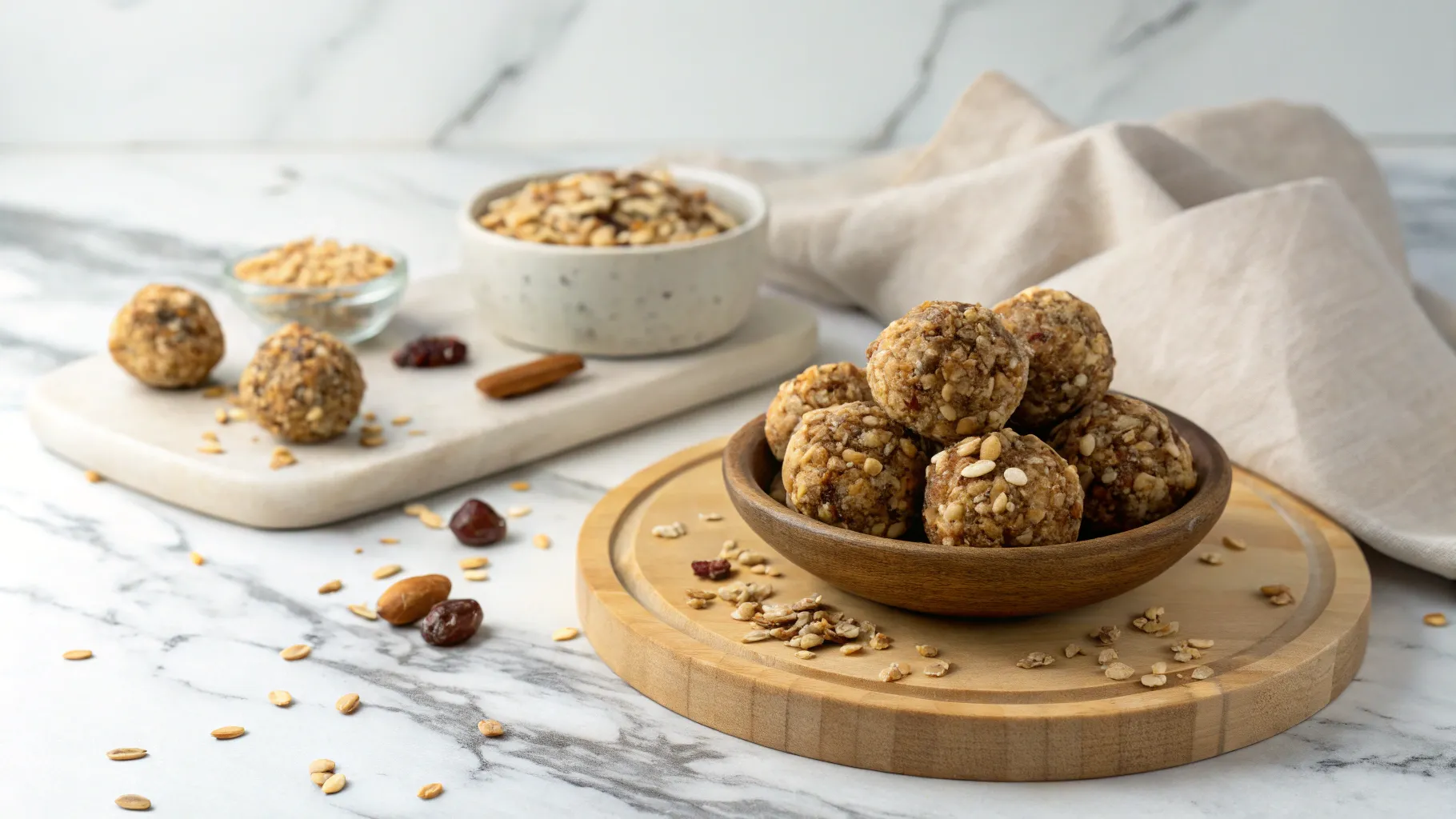
Why Make Granola at Home?
Let’s be honest, store-bought granola may be convenient, but it often comes with hidden sugars, processed oils, and ingredients you can’t pronounce. That’s why more and more people are opting to make homemade granola recipe, and once you try it, you’ll understand why.
By crafting it yourself, you gain full control over what goes into your body. No mystery ingredients. No preservatives. Just real, whole foods you choose.
1. Tailored Sweetness & Texture
Prefer it extra crunchy? Want it lightly sweetened? Homemade granola recipe lets you customize:
- The amount and type of sweetener (maple syrup, date paste, honey)
- The bake time for desired crunchiness
- Add-ins like spices, seeds, dried fruit, or superfoods
2. Budget-Friendly
Buying premium granola at the store can be pricey. By purchasing your oats, seeds, and nuts in bulk, you’ll save significantly over time, especially if you eat granola regularly.
3. No Allergens or Additives
Whether you’re avoiding:
- Nuts
- Gluten
- Dairy
- Refined sugar
You can make a version that suits your dietary needs without compromising flavor or texture.
4. Endless Customizations
From superfood blends with hemp and chia seeds to keto-friendly mixes with coconut and almonds, this granola recipe can be adapted to fit your lifestyle, goals, and cravings.
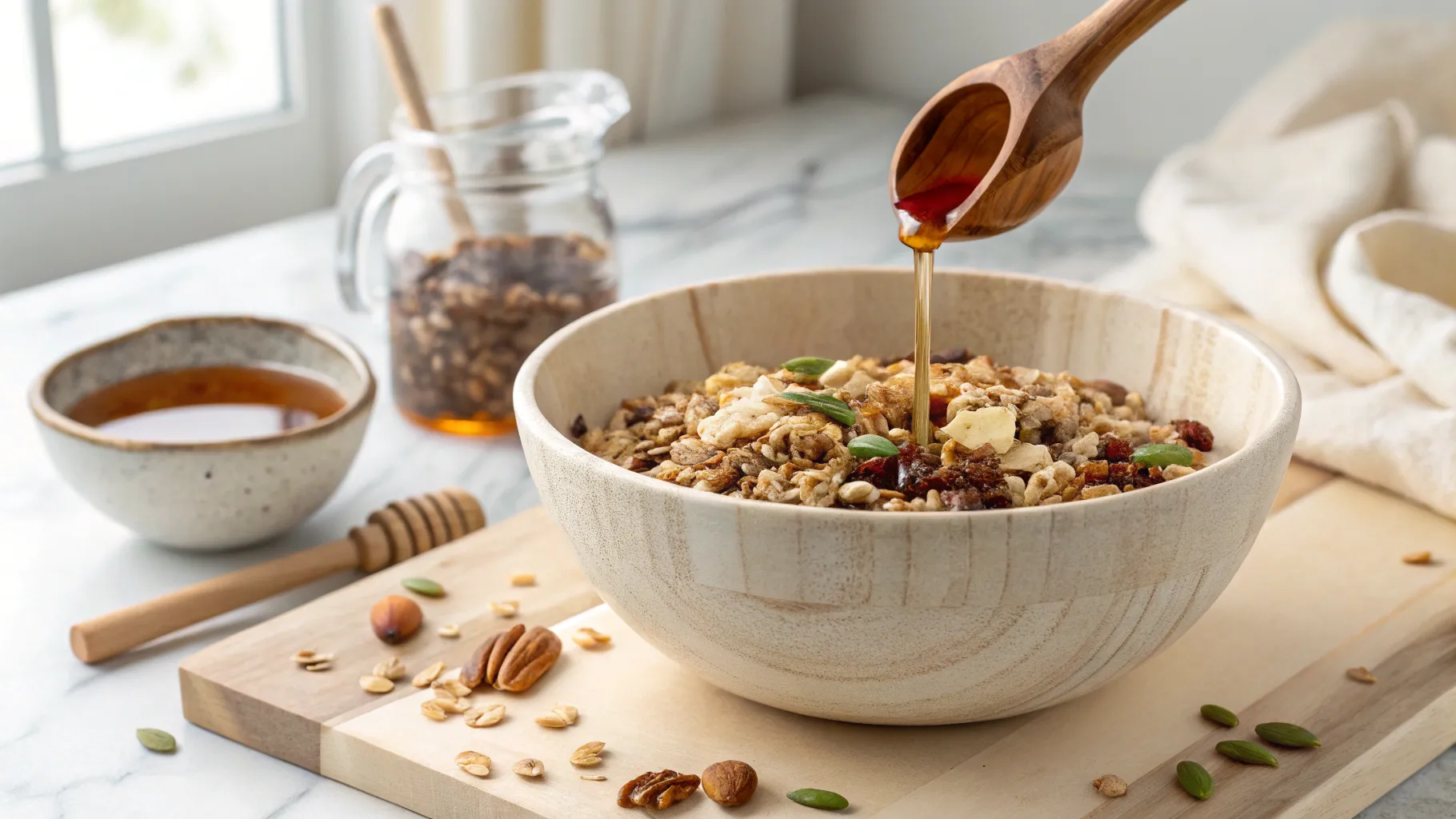
Basic Homemade Granola Recipe
Ingredients:
- 3 cups rolled oats
- 1 cup chopped nuts (e.g., almonds, pecans)
- ½ cup seeds (e.g., pumpkin or sunflower)
- ⅓ cup maple syrup or honey
- ¼ cup coconut oil
- 1 tsp vanilla extract
- 1 tsp cinnamon
- ½ tsp salt
- ¾ cup dried fruit (added after baking)
Instructions:
- Preheat oven to 325°F (160°C). Line a baking sheet with parchment paper.
- Mix dry ingredients in a large bowl (oats, nuts, seeds, spices).
- In a small pan, warm sweetener, oil, and vanilla. Pour over dry mix.
- Spread onto baking sheet and bake for 20–25 minutes, stirring halfway.
- Let cool completely before adding dried fruit and storing.

Granola for Every Diet
One of the best things about a granola recipe is how easily it adapts to your dietary preferences or restrictions. Whether you’re vegan, gluten-free, or low-carb, there’s a granola combination for you.
1. Vegan Granola Recipe
- Use maple syrup or agave nectar instead of honey
- Choose dairy-free chocolate chips or dried fruit for add-ins
2. Gluten-Free Granola Recipe
- Use certified gluten-free oats
- Ensure mix-ins (like dried fruits or spices) are gluten-free too
3. High-Protein Granola Recipe
- Add hemp seeds, chia seeds, or protein powder
- Include chopped nuts and pair with Greek-style plant-based yogurt
4. Low-Sugar Granola Recipe
- Sweeten with mashed banana, date paste, or monk fruit syrup
- Skip chocolate chips or sweetened dried fruit
5. Nut-Free Granola Recipe
- Use sunflower seeds, pumpkin seeds, or toasted coconut flakes
- Avoid nut oils, swap with olive or rice bran oil
💡 Pro tip: No matter the dietary path you follow, you can enjoy crunchy, wholesome granola that fuels your day.

How to Eat Granola: Delicious Serving Ideas
Once you’ve nailed the perfect granola recipe, the real fun begins, finding creative, crave-worthy ways to enjoy it. Granola isn’t just for cereal bowls; this crunchy, wholesome mix fits effortlessly into every part of your day, breakfast, snack time, or even dessert. Whether you’re on the go or building a cozy brunch plate, granola adds that satisfying crunch and a nutrient boost to any meal.
Here are some of the tastiest and easiest ways to enjoy your granola, especially if it’s homemade.
1. With Yogurt
- Layer it into a parfait with your favorite plant-based yogurt and fresh fruit like berries, mango, or banana
- Add a drizzle of maple syrup or a spoonful of nut butter for extra richness
- Great for meal prepping in jars for grab-and-go mornings
2. As Cereal
- Pour your granola into a bowl and top with oat milk, almond milk, or any milk alternative
- Toss in fresh fruit like strawberries or blueberries
- Sprinkle cinnamon or cocoa powder for added flavor
3. Smoothie Bowl Topper
- Use granola as a crunchy topping for smoothie bowls made with: Frozen banana, spinach, berries, plant-based protein powder
- Finish with coconut flakes or a dollop of nut butter
4. On Toast
- Spread almond butter, peanut butter, or tahini on whole grain toast
- Top with a spoonful of granola and sliced banana or apple
- Add a drizzle of honey or agave for a sweet finish
5. Baked Apples or Pears
- Core apples or pears and fill the center with granola before baking
- Sprinkle with cinnamon and a dash of maple syrup
- Serve warm with a dollop of coconut yogurt or non-dairy ice cream
6. Granola Energy Balls
- Mix granola into a blend of dates, nut butter, chia seeds, and coconut
- Roll into bite-sized energy balls
- Perfect for snack prep, lunchboxes, or workout fuel
💡 Pro tip: Granola is your flexible food friend, easy to use, endlessly versatile, and packed with nutrients.
7. Bake & Take Options:
- Fold into muffin batter
- Sprinkle onto banana bread before baking
- Stir into homemade cookies or energy bars
💡 Pro tip: Granola isn’t just for mornings, take it to work, the gym, or even your next picnic.
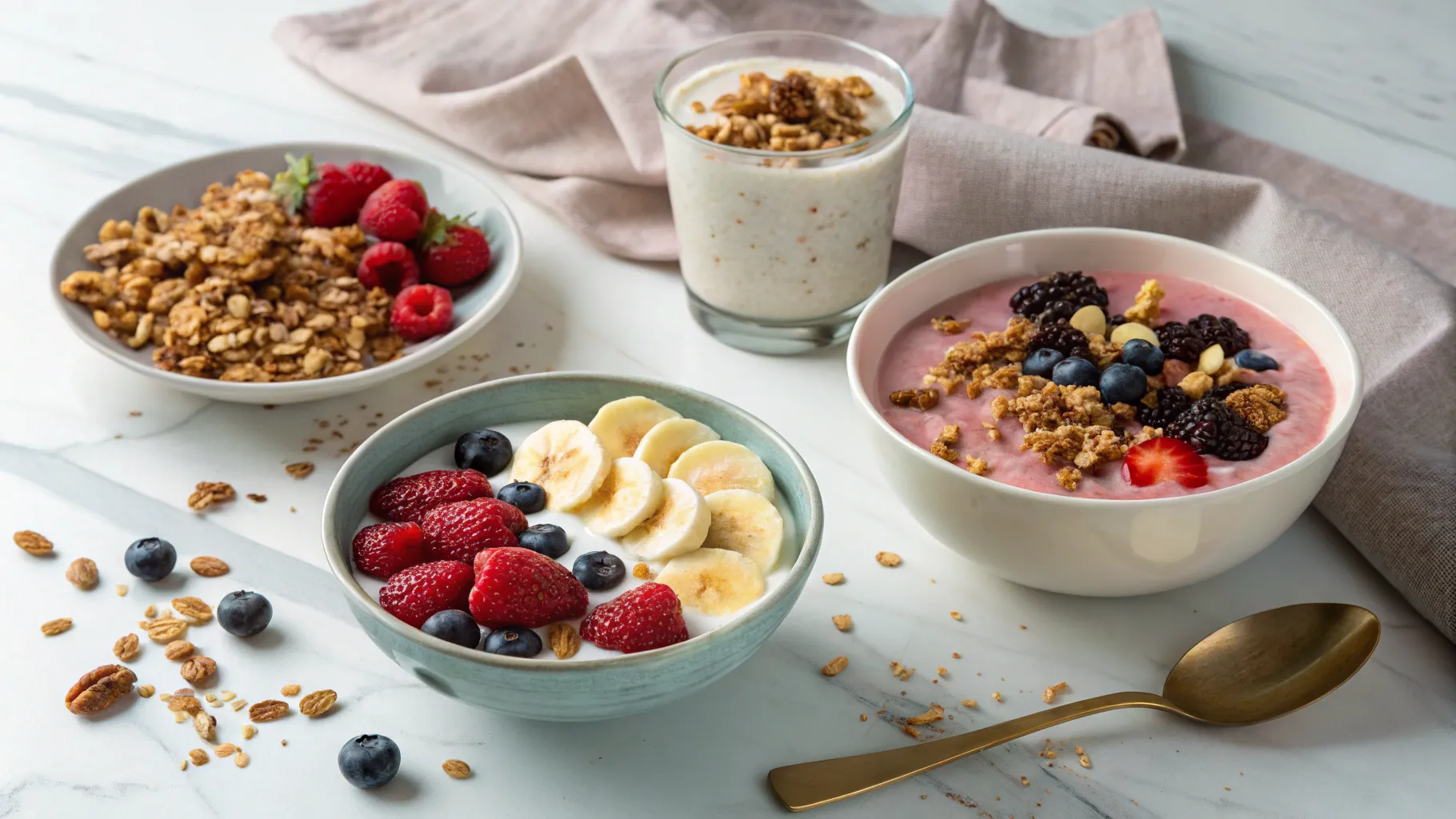
Storage Tips & Shelf Life
To keep your homemade granola fresh, crispy, and safe from sogginess, proper storage is key.
1. Best Ways to Store Granola:
- Let it cool completely before storing
- Use an airtight container or a resealable glass jar
- Store in a cool, dry place (pantry or cupboard)
2. Can You Freeze Granola?
Yes! Granola freezes well:
- Place in freezer-safe bags or containers
- Remove excess air before sealing
- Freeze for up to 3 months
- Thaw on the counter for 10–15 minutes before serving
💡 Pro tip: Always add dried fruit after baking to prevent moisture build-up.
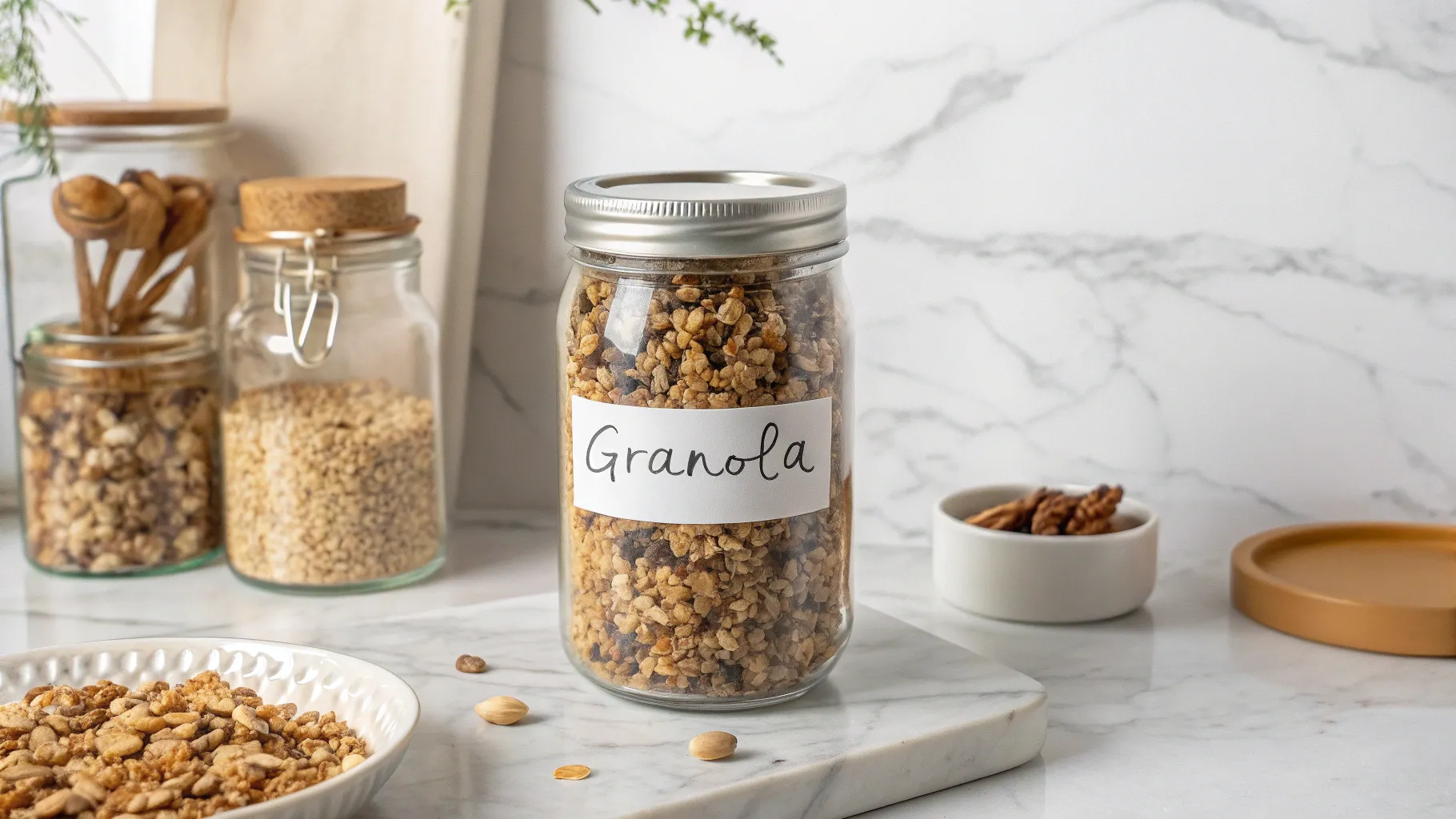
Frequently Asked Questions About Granola Recipe
We’ve gathered the most searched granola recipe questions based on Google’s People Also Ask section, so you can get clear, honest answers, all in one place.
Q1: Is granola healthy or fattening?
Granola can be very healthy, especially when homemade. It’s full of fiber, protein, and healthy fats. However, store-bought versions often contain excess sugar and oils, which can lead to high calorie intake. The key is portion control and clean ingredients.
Q2: Is granola gluten-free?
It can be! While oats are naturally gluten-free, they’re often processed in facilities that handle wheat. Always choose certified gluten-free oats and double-check mix-ins.
Q3: Does granola help with weight loss?
In moderation, yes. The fiber and protein in granola recipe help with satiety, which may reduce overall calorie intake. Stick to ¼–½ cup servings and avoid versions with high sugar content.
Q4: Does granola spike blood sugar?
If it contains refined sugar or high-fructose corn syrup, it might. Opt for low-sugar granola using natural sweeteners like maple syrup, date paste, or fruit.
Q5: Is granola good for digestion?
Yes! Oats are rich in prebiotic fiber, which feeds healthy gut bacteria. Seeds and nuts also help support digestion thanks to healthy fats and fiber.
Q6: Can I eat granola every day?
Absolutely, especially if you stick to a balanced granola recipe that isn’t overloaded with sugar. For variety, rotate ingredients like nuts, seeds, and dried fruits to keep your nutrition diverse and your breakfasts exciting.
Q7: How much granola should I eat?
A typical serving is ¼ to ½ cup, depending on how it’s used (as a snack vs. cereal base). Pairing it with fruit or yogurt helps round out the meal.
Q8: How can I reduce sugar in homemade granola?
Use natural sweeteners like:
- Mashed banana
- Applesauce
- Coconut nectar
- Date syrup
- Monk fruit sweetener
Also, skip chocolate chips or sweetened dried fruits.
Final Thoughts
From the first golden granola recipe you bake to your next smoothie bowl masterpiece, granola is that comforting, crunchy constant that makes healthy eating feel like a treat. Whether you’re stirring it into yogurt, packing it as a snack, or spooning it over fruit, it fuels your day without fuss.
By making your own at home, you unlock:
- Better nutrition
- Lower cost
- Endless customization
- Zero mystery ingredients
So go ahead, bake a batch. Your mornings (and your body) will thank you.
💡 Enjoyed this recipe?
Follow us for daily kitchen tips and tasty inspiration!
📌 Pinterest | 📘 Facebook | 📸 Instagram
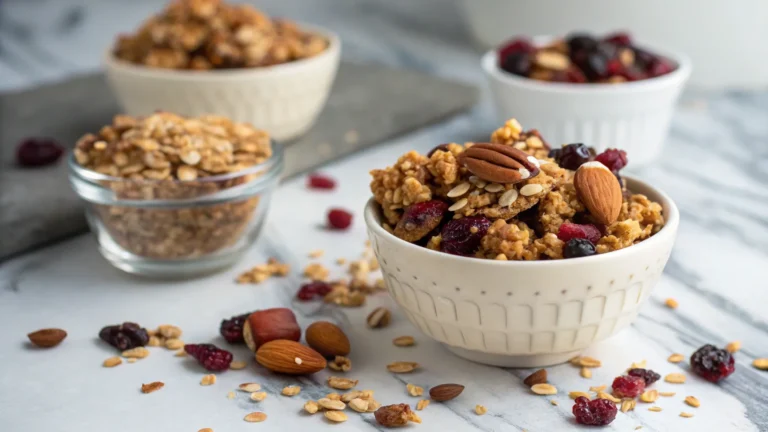
Granola: A Wholesome Crunch That Works for Every Lifestyle
This healthy homemade granola is naturally sweetened, crunchy, and endlessly customizable. Perfect for breakfast, snacking, or topping smoothie bowls, it’s budget-friendly, easy to make, and suits nearly every diet.
- Total Time: 30 minutes
- Yield: About 5 cups (10–12 servings) 1x
Ingredients
- 3 cups rolled oats (gluten-free if needed)
- 1 cup chopped nuts (e.g., almonds, pecans, walnuts)
- ½ cup seeds (pumpkin, sunflower, or chia)
- ⅓ cup maple syrup or honey
- ¼ cup melted coconut oil or olive oil
- 1 tsp vanilla extract
- 1 tsp ground cinnamon
- ½ tsp sea salt
- ¾ cup dried fruit (e.g., raisins, cranberries, dates – added after baking)
Instructions
- Preheat oven to 325°F (160°C) and line a baking sheet with parchment paper.
- In a large mixing bowl, combine oats, nuts, seeds, cinnamon, and salt.
- In a saucepan or bowl, whisk together maple syrup, oil, and vanilla.
- Pour the wet mixture over the dry and mix until evenly coated.
- Spread the granola evenly on the baking sheet and bake for 20–25 minutes, stirring halfway.
- Let it cool completely before adding dried fruit.
- Store in an airtight container at room temperature for up to 3 weeks.
- Prep Time: 5 minutes
- Cook Time: 25 minutes
- Category: Breakfast, Snack, Pantry Staple
- Method: Baked, Stirred
- Cuisine: American, Health-Inspired

